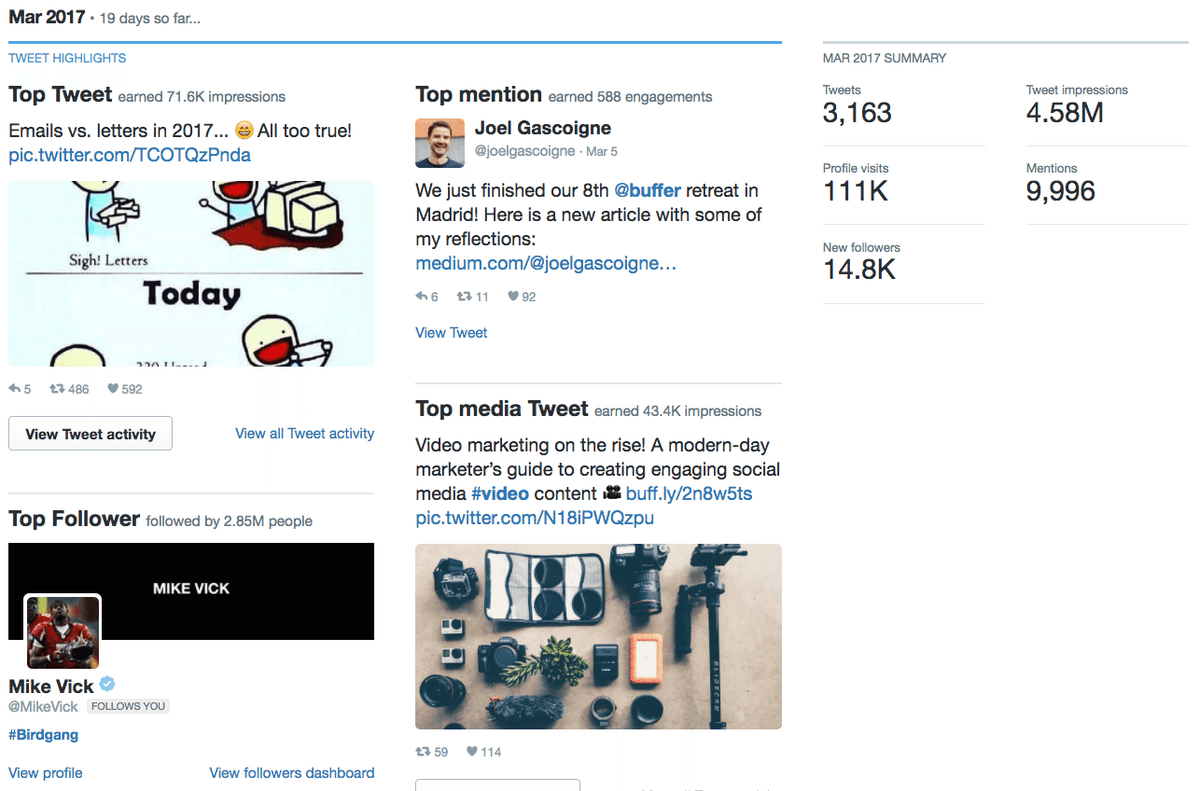
We social media marketers are a lucky bunch not only are there a gigantic number of free social media tools available to us (everything from Schedule tools to social media management tools like Amortize), there are free social media tools themselves: Facebook Outlook, Pinterest analytics, and now Twitter analytics, too.
We now have tons of information at our fingertips.
The perfect next step: knowing that we are looking for the right numbers and drawing the right conclusions from the data, simply and easily.
When it comes to Twitter analytics and Twitter metrics in general, I’ve done a bit of research on what exactly we can learn – as simply as possible – from all of the awesome numbers that Twitter is showing off. Read on to see what I came up with and if you can get any insight from these stats as well.
The best tools to discover the best Twitter statistics
I have found a lot of value in a few simple tools for discovering the best stats and analytics for Twitter. My go-to Twitter reporting tool is my social media analysis tool, Buffer Analysis.
With Buffer Analyze, I can get a quick overview of essential stats and a detailed look at the performance of my latest tweets – including clicks, retweets, likes, and impressions.
Twitter Analytics Dashboard (direct link: https://analytics.twitter.com ) is a great free alternative that also provides a lot of useful stats for marketers.
For some things, Twitter’s analytics go to a more detailed micro-level.
For example, for the number of impressions, which is the number of times your tweet appeared in people’s feeds, you can get detailed information about when and where each of those impressions was made. The same goes for click statistics and engagement metrics (likes, retweets, etc.). Twitter analytics tells you where on the tweet and where on the network someone clicked or interacted with your tweet.
How to access Twitter Analytics
The Twitter analysis is open to everyone. If you tweet – whether as a business, brand, or individual – you can get full Twitter analytics on your tweets and followers.
In the left sidebar, click on ‘More’ then ‘Analytics’.
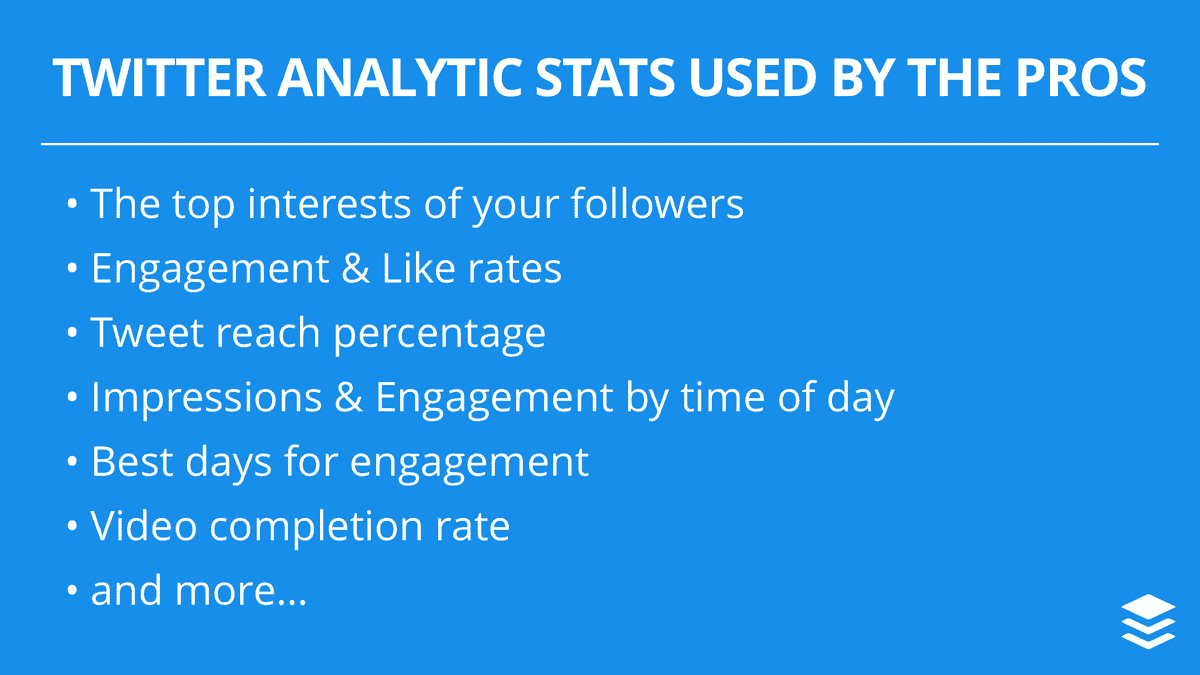
Once you access Twitter’s analytics for the first time, Twitter will start pulling impression and engagement data for tweets. If your analytics dashboard seems a bit stripped down at first, give it time.
The instances where you should be able to access the scans would be:
- Mainly counts tweets in Arabic, Brazilian Portuguese, Danish, Dutch, English, Filipino, Finnish, French, German, Indonesian, Italian, Japanese, Korean, Norwegian, Russian, Simplified Chinese, Spanish, Swedish, Thai, Traditional Chinese, and Turkish
- The account is at least 14 days old
- Account does not violate policy
- The account is not deleted, restricted, protected, or suspended
15 most useful Twitter analytics statistics used by pros
I’ve found a lot of inspiration in how others have used Twitter analytics to find stats and insights that help them tweet better. Here’s my collection of 15 favorites, along with how you can find those stats for your Twitter profile.
1. Monthly performance overview
What are your best tweets?
On the home page of your Twitter analytics, you’ll get a 28-day summary of your Twitter account and a summary of each of the previous months.
The Monthly Summary is a great way to get a quick overview of your Twitter performance for each month. On the left, you’ll see the highlights of your tweet, which includes:
- Top tweet: The tweet that received the most impressions
- Top Mention: The tweet mentioning your @handle that received the most impressions (this may include other people’s tweets)
- Top follower: The account with the highest number of subscribers that followed you during the month
- Top media tweet: The tweet with photo or video that received the most impressions
- Top Card Tweet (if using card tweets): the tweet with a Twitter card that received the most impressions (this may include other people’s tweets)
Here are some ways to use this information:
- Top tweet/media tweet: share it next month – with a fresh copy
- Primary Mention: Retweet the tweet
- Best follower: reach out, thank the person for following up, and start a conversation
On the right, you’ll see some key stats from your Twitter account for the month. These numbers are great for reporting purposes – to show your monthly performance and determine monthly growth.

If the month is not over, Twitter will show you the data up to the current date of the month.
How to find this for your profile: Go to analytics.twitter.com, and it will be right there!
2. Trend data
How are your social media strategies going?
When we focus on day-to-day social media activities, we can sometimes miss the big picture. Taking a step back and examining trends in our social media performance can tell us if our strategies are working in the long term.
Is there a general upward trend? Or is it flat?
Once you’ve spotted the trends in your Twitter performance, it can be helpful to Analyze Buffer, you can get charts of key metrics like clicks, likes, and followers. And you can compare them with the previous period.

If you prefer to use Twitter’s native analytics dashboard, you can find trending data for five engagement metrics on the right of the ‘Tweets’ page.
3. Average performance for benchmarking
How do your tweets behave about your goals?
As the graph above shows, Twitter statistics tend to fluctuate daily. It is therefore difficult to compare your performance for a period (for example a month) with the previous period.
A good solution for this is to use averages.
Averages smooth out fluctuations for easy comparison. You can easily compare the average performance of your tweets for this month with that of the previous month and quickly see if your Twitter performance has improved.
How to find this for your profile: In Buffer Analysis, you get impressions, engagements, and average clicks per tweet under the Overview tab.

You can also find similar data in Twitter’s analytics dashboard.
Once you’ve found your averages, you can use them to set your social media benchmarks and analyze your performance.
4. The top 10 interests of your subscribers
What topics resonate with your followers?
Social media reviewer Alex Bossenger wrote a great overview of all you can get from Twitter analytics. I often think of Twitter analytics as to the data behind the tweets. But there is also comprehensive data behind the subscribers!
Twitter shows you the top 10 interests of your followers. There is a bit of a mystery behind how Twitter finds this number. The official word in Twitter’s documentation is
The Main Areas Of Interest That Set Your Followers Apart From The Average Twitter
Use these interests as a good guideline for content and ideas, even if the scientific explanation is not obvious.
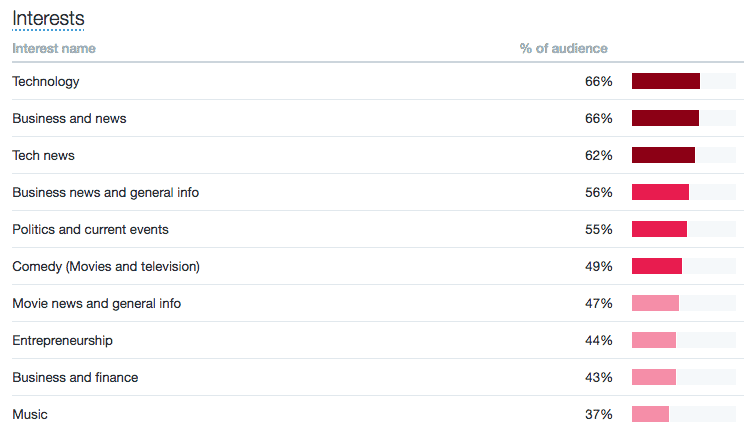
How to find this for your profile: Go to analytics.twitter.com and click on ‘Audiences’ from the menu at the very top of the page. Interest will be on the main subscriber dashboard.
If you want to know more about your subscribers, you can click on the ‘Demographics’ or ‘Consumer Behavior’ tab to see their age range, country, buying styles, etc.
5. Type of engagement
Are you retweeted or liked?
If you find that your engagement numbers are high for a handful of posts in particular, does that mean that each of those posts performed the same? There is probably more to tell.
You can dig deeper into your engagements by noticing what specific types of engagements have taken place. For example, were they retweets or likes?
Retweets can be a sign of value. Someone has found your tweet valuable enough to share with their audience.
Likes can be a sign of appreciation. Your tweet resonated with someone else, and they wanted to give a virtual high-five.
Both measures count as a commitment. Both tell a unique story.

How to find this for your tweets: You can quickly and easily access this breakdown for an individual post right from your Twitter analytics dashboard, click ‘Tweets’ in the top navigation bar, then click’ View tweet activity ‘for any tweet on this list.
Outside of your Twitter analytics dashboard, you can also get this breakdown by clicking on the bar graph icon on the tweet you’re interested in.
6. Engagement rate
Which messages resonate the most?
There are a few obscure stats that might fool you in Twitter’s tweet dashboard. (See below for details.) The engagement rate is not one of them.
This is super useful because it shows the number of engagements divided by impressions.
In other words, out of all the people who saw the tweet, what percentage of people did something with it.
Twitter counts engagement every time someone clicks anywhere on the tweet, including:
- retweets
- responses
- follows
- favorites
- connections
- cards
- hashtags
- integrated media
- username
- profile picture
- tweet expansion
How to find this for your tweets: Buffer Analyze automatically calculates the engagement rate for all your tweets.
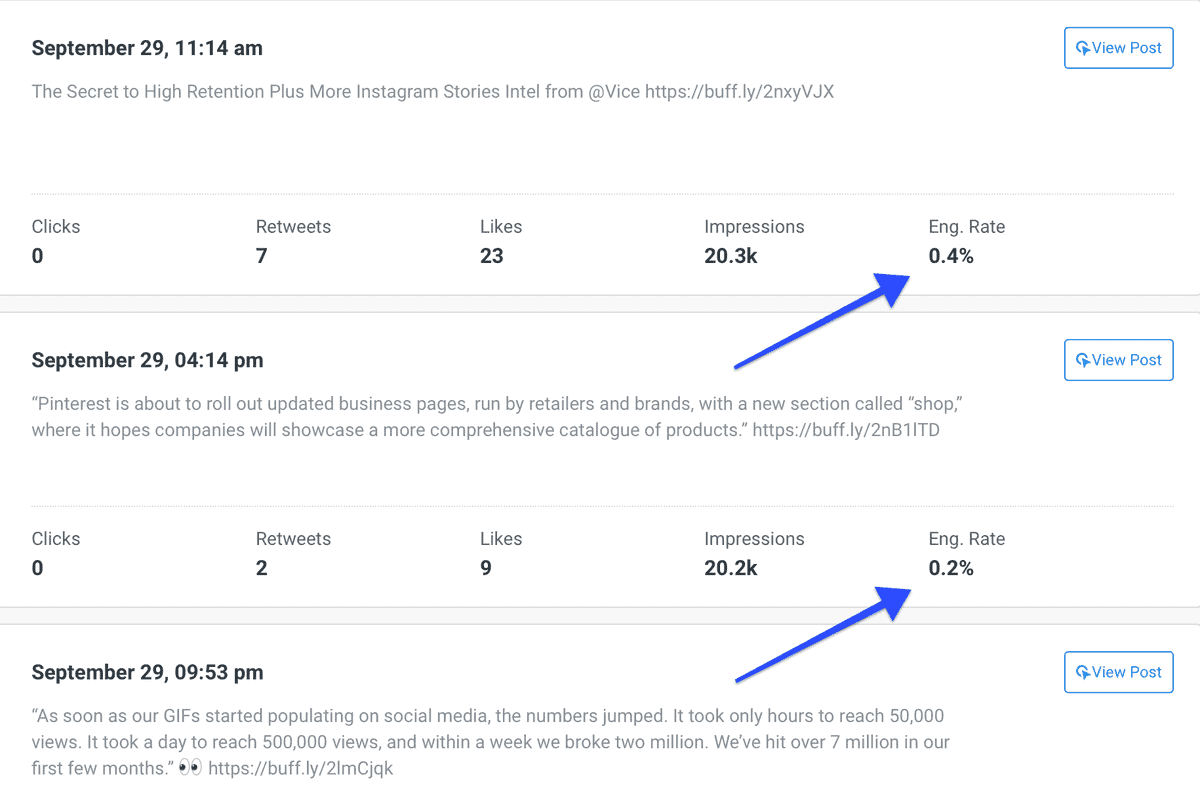
You can also get this information – and much more – in the exported data offered by Twitter Analytics.
Prepare your spreadsheets!
The rest of the stats here will refer to the exported Twitter data, so get your spreadsheets ready!
From the dashboard, go to “Tweets” and click on the export button in the upper right corner.

Take the downloaded file and import it into Excel or Google Sheets. It will look something like this spreadsheet .
Twitter will show you data for up to 3,200 tweets, including a breakdown of all impressions and other engagement numbers.
Pro Type: You can remove all @ replies from the spreadsheet by sorting the “Tweet Text” column alphabetically and removing the rows that start with the @ symbol.
7. Twitter Like Rate
What are your best tweets?
And Shure’s evolution of SEO has come up with a unique statistic that can help you predict the success of a piece of content. He calls it preferred rate (or maybe now, like rate).
Twitter users distribute likes for several different reasons, and one of them could be that they quite like the idea that you are expressing in a tweet. A similar rate helps bring out the best ideas. It measures favorites through impressions, highlighting which posts received the most love versus the number of people who viewed them.
Here’s how Dan associates everything with content creation :
For Twitter, It’s Probably Safe To Assume That The Tweets People Prefer Would Be A Good Article, Blog Posts, Tools, And Ideas – Because Your Audience Told You They Liked The Idea With Their Engagement. At Least The Content Of Those Tweets Caught Their Attention For Some Reason.
How to find this for your tweets: Divide likes by impressions. Format the resulting data as a percentage. Here is!
8. Tweet duration vs engagement
What is the ideal length for your tweets?
We’re always keen to get data on the ideal length of tweets, so this one might turn out to be insightful.
What you’ll learn is exactly how the length of your update affects how your audience interacts with it. Are they blind to long 140 character updates? Do they prefer short or medium? Once you’ve seen the general trends, you can even dig deeper to see what kind of engagement (say, retweets vs. favorites) is happening at each particular length.
How to find this for your tweets: To find this statistic, you need to add a new column to your spreadsheet.
Create a new column and copy this formula into the cells:
= LEN (A1)
(Replace “A1” with the cell containing the text of the tweet.)
The above formula will give you the character number of the tweet, including the article URL and the image URL. (The URL of the image is not counted in your tweets so this number of characters can exceed 140, which is normal as we are mostly interested in general trends rather than a specific number of characters).
To get the word account, try this formula:
= IF (LEN (TRIM (C2)) = 0,0, LEN (TRIM (C2)) – LEN (SUBSTITUTE (C2, ”,” ”)) + 1)
Armed with this data, you can then compare your engagement with the length of your tweet. An interesting way to do this is to run a scatter plot with the data in the Commitment column and the Length column.
Here is the data of our last 150 Buffer tweets (excluding viral tweets).

9. Percentage of audience for tweets
How many of your subscribers are you reaching?
Facebook reach is a pretty ballyhooed statistic. Now that we have the impression data from Twitter, we can basically find the same statistic for tweets.
One of the best takeaways from this statistic is that you’ll find out whether or not you need to share your tweets multiple times in order to reach your audience more (there’s a good chance you’ll be reshare).
How to find this for your tweets: Since you already have your impression statistics, you just need to divide the impressions by the total number of subscribers.
Create a new column in the spreadsheet and add this formula for each tweet:= Impressions/Total Number Of Subscribers
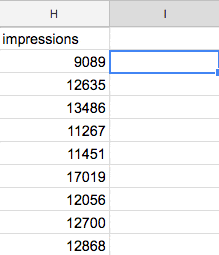
(802,920 is the number of subscribers we have during the calculation. Your number of subscribers will likely have increased throughout the period of your analysis. Use your last number of subscribers for more conservative calculations.)
(One area this statistic won’t take into account is the effect of viral sharing. Impressions can include people who don’t follow you, so your actual audience percentage of your followers can be a bit skewed, especially if you are promoting tweets. We also assume that a person only sees our tweet once.)
10. Comparison of hashtags
How do impressions, engagement, and engagement rates compare?
Suppose you often tweet with a bunch of must-see hashtags, for example, #socialmedia, #seo, and #inbound. With Buffer Analyze, you can see which of these tags is performing better.
How to find this for your tweets: Under the Posts tab in Buffer Analyze, there’s a table that ranks the hashtags you’ve used based on their average impressions or engagement rate.

11. Impressions by the time of day
When is the best time to post to maximize impressions?
Redpoint’s Tomasz Tunguz came up with some really helpful ways to break down his Twitter stats. The following handful of stats are courtesy of Tomasz. (You can see his info on Twitter in his full blog post.)
First of all, impressions at the time of day.
What time of day is it best to post so that most people can see a tweet?
Followerwonk is some Twitter tool that can help you find that answer, depending on when your followers are likely to be online. Digging into your Twitter analytics will tell you the best time based on how well your tweets have performed in the past.
How to find this for your tweets: In your exported spreadsheet, change the formatting of the Time column to show the numbers in minutes/hours instead of the full timestamp.
Here is a formula that will only extract the date and time from the full timestamp.
= ArrayFormula (Middle (D2: D, 1,16))
You can paste it in the top row of a new column. ArrayFormula will fill the data throughout the column. Once that data is there, copy it to your clipboard and “paste it as values” in a new column (preferably on a new sheet to keep things clean). This will allow you to format the numbers as you see fit.
Once you have formatted the date and time correctly, you can start analyzing the data.
Another trick you might want to try is rounding off the hour to the nearest hour and then comparing the impressions to the hour. Here is the formula:
= ROUND (A2 / (1/24), 0) * (1/24)
(Replace “A2” with the cell containing the time of the tweet.)
Once you have the time in hours, you can create a PivotTable (with the row set to Time and the value set to Average Impressions) to compare the time to the Average Impressions of Tweets.

Useful definitions of what you’ll see on your dashboard
Once you’ve exported your Twitter stats, you’ll likely see a bunch of columns that you might not immediately be familiar with. Here are some useful definitions :
- Application installation attempts: Clicks to install an application via the Tweet card
- The application opens: Clicks to open an application via the Tweet card
- The detail expands: Click on the Tweet to display more details
- Embedded media clicks: Clicks to display a photo or video in the Tweet
- Engagements: The total number of times a user has interacted with a Tweet. Click anywhere on the Tweet, including retweets, replies, follows, likes, links, cards, hashtags, embedded media, username, profile picture, or extension by Tweet
- Engagement rate: Number of engagements divided by impressions
- Follows: Number of times a user has followed you directly from the Tweet
- Hashtag clicks: Click on the hashtag (s) in the Tweet
- Impressions: The times a user receives a Tweet in the timeline or search results
- Leads Submitted: Number of times a user has submitted their information via the lead generation card in the Tweet
- Likes: Number of times a user liked the Tweet
- Link clicks: Click on a URL or a map in the Tweet
- Clicks on the permanent link: Clicks on the permanent link of the Tweet (desktop only)
- Responses: Number of responses a user has to the Tweet
- Retweets: Number of times a user has retweeted the Tweet
- Shared by Email: Number of times a user tweeted to someone
- User Profile Clicks: Click on the Tweet author’s name, @handle, or profile picture
Start exploring your Twitter data
First of all, it’s amazing that Twitter has passed on such detailed analytics to users on the engagement and metrics behind the tweets.
If you haven’t already, go to your Twitter analytics dashboard now (it’s free and easy), and take a look around.
When you’re ready for the next step, try one of the 11 essential Twitter stats above and see if what you discover could help you tweet better. Need a starting point? I found the statistics per day and per hour to be the most fascinating to me.
